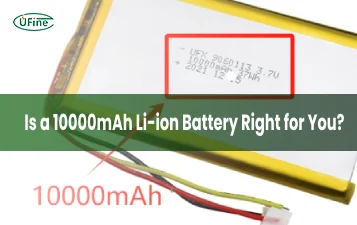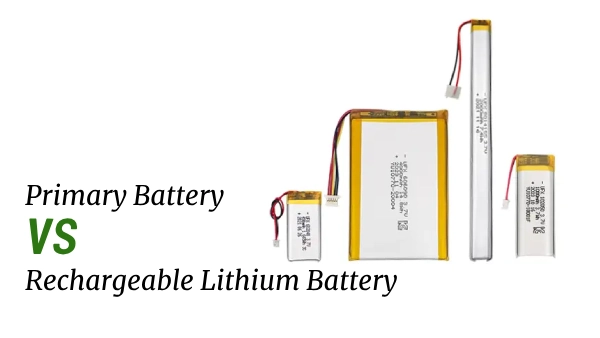Lithium batteries are standard rechargeable batteries widely used in mobile devices, electric vehicles, and energy storage systems. In the manufacturing process of lithium batteries, primary batteries, and rechargeable lithium batteries are two different concepts. This article will detail the difference between primary and rechargeable lithium batteries.
Part 1. Definition of primary battery and rechargeable lithium battery
What is a primary battery?
Primary batteries, also known as non-rechargeable lithium batteries, can only be used once and cannot be recharged. Primary batteries usually use a non-reversible chemical reaction, and after the battery is discharged, the reactants cannot be regenerated, so they cannot be used again.
What is a rechargeable lithium battery?
Rechargeable lithium batteries, also known as rechargeable lithium batteries, can be recharged to restore energy storage and be used again. Rechargeable lithium batteries usually adopt a reversible chemical reaction to restore the reactants to their original state by applying an electric current so that the battery can be recharged and used.
Part 2. Structure of primary battery and rechargeable lithium battery
Structure of primary battery
The primary battery usually consists of a positive electrode, a negative electrode, an electrolyte, and a diaphragm. The positive electrode is usually metal oxide or halide, and the negative electrode is metal or alloy. The electrolyte is usually liquid or solid and is used for ion transport. The diaphragm isolates the positive and negative electrodes to prevent short circuits.
Structure of rechargeable lithium battery
The structure and composition of a rechargeable lithium battery are similar to that of a primary battery, which also includes a positive electrode, a negative electrode, an electrolyte, and a diaphragm. However, the materials and design of rechargeable lithium batteries are more complex to achieve rechargeable performance.
The cathode material of rechargeable lithium batteries is usually a lithium compound, such as lithium iron phosphate (LiFePO4) or lithium cobaltate (LiCoO2). The negative electrode material is usually a carbon material, such as graphite. The electrolyte is usually an organic solution or polymer gel for lithium ion transport.
Part 3. Principles of primary batteries and rechargeable lithium batteries
Principle of primary battery
Primary batteries convert chemical energy into electrical energy through a non-reversible chemical reaction. During the discharge process, the chemical reaction between the positive and negative electrodes produces an electron flow, generating an electric current. After a primary battery is discharged, the reactants cannot be regenerated and, therefore, cannot be used again.
Principle of rechargeable lithium battery
The working principle of rechargeable lithium batteries is to convert chemical energy into electrical energy through reversible chemical reactions and to convert electrical energy into chemical energy during charging. During the discharge process, the chemical reaction between the positive and negative electrodes generates the flow of electrons, thus generating an electric current. The current is reversed during charging, returning the reactants to their original state to store electrical energy.
Part 4. Charge and Discharge of Primary Batteries and Rechargeable Lithium Batteries
Charge and discharge of primary battery
Primary batteries usually have low charge/discharge performance and limited capacity. Primary batteries are usually designed for single use and, therefore, require less capacity and cycle life.
Charge and discharge of rechargeable lithium batteries
Rechargeable lithium batteries have better charge/discharge performance and higher capacity and can be recharged and discharged many times. Rechargeable lithium batteries are usually designed to be rechargeable, with high capacity and cycle life requirements.
Part 4. Environmental Impacts of Primary Batteries and Rechargeable Lithium Batteries
Primary battery
Primary batteries usually contain hazardous substances, such as heavy metals, acids, and alkalis, which cause environmental pollution. Primary batteries usually require special treatment after use to prevent leakage of hazardous substances.
Rechargeable lithium batteries
Rechargeable lithium batteries usually do not contain hazardous substances and have less environmental impact. Rechargeable lithium batteries can be reused, which reduces the consumption of natural resources and is more friendly to the environment.
Part 5. Summary
To sum up, there are obvious differences between primary and rechargeable lithium batteries in terms of definition, structure, principle, charging/discharging, environmental impacts, etc. Batteries should be selected reasonably according to different usage scenarios.
Part 6. FAQs
-
How should I charge a rechargeable lithium battery?
To charge a rechargeable lithium battery, use a compatible charger specifically designed for lithium batteries and follow the manufacturer’s instructions for the correct charging procedure. -
Can air transport rechargeable lithium batteries?
Rechargeable lithium batteries can typically be transported by air. Still, specific regulations and restrictions depend on the capacity and quantity of the batteries. It’s best to check with the airline and follow their guidelines. -
Can rechargeable lithium batteries be brought on board a plane?
Rechargeable lithium batteries are generally allowed in carry-on luggage on planes, but restrictions may apply. It’s important to comply with airline regulations and guidelines regarding the transport of lithium batteries. -
How long do rechargeable lithium batteries last?
The lifespan of rechargeable lithium batteries varies depending on usage patterns, charging methods, and operating conditions. Typically, they can last for several years before experiencing significant capacity loss. -
What are the charging times and lifespan of lithium batteries?
The charging times of lithium batteries depend on the battery capacity and the charger’s specifications. Fast-charging options are available, and the lifespan of lithium batteries can range from a few hundred to a few thousand charge cycles, depending on the battery chemistry and usage conditions.
Related Tags:
More Articles

10000mAh Battery Explained: How Long It Lasts, How It Works
A full guide on 10000mAh li-ion batteries, voltage, usage time, and tips. Discover how a 10000mAh battery works, how long it lasts, and how to choose.
10440 Battery Guide: Size, Voltage, Capacity, Uses & More
Understand 10440 batteries better—size, voltage, safety, and how they compare to AAA. Find the best fit for your high-performance devices.
White Stuff on Battery Terminals: A Step-by-Step Cleaning and Maintenance Guide
White stuff on battery terminals is corrosion. Learn how to clean it safely, prevent damage, and keep your battery running strong with simple steps.
Understanding How Glass Mat Batteries Work: Technology, Benefits, and Limitations
Glass mat batteries power cars, RVs, and solar systems. Learn how they work, their benefits, and what to consider before choosing one.
A Buyer’s Guide for AA Size Lithium Battery
Discover the power of AA size lithium batteries—types, voltage, capacity, and more! Learn how to choose the best one for your needs. Read now!




